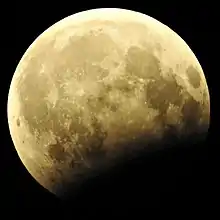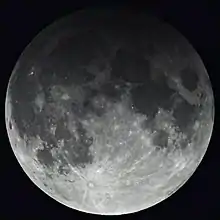May 2023 lunar eclipse
A penumbral lunar eclipse occurred on Friday, 5 May 2023, the first of two lunar eclipses in 2023. The moon's apparent diameter was 0.1% larger than average because it occurred 5.5 days before perigee (Perigee on 11 May 2023). This was the deepest penumbral eclipse (with –0.0457 magnitude) since February 2017 and until September 2042.[1]
| Penumbral eclipse | |||||||||
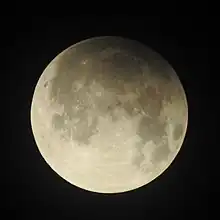 | |||||||||
| Date | 5 May 2023 | ||||||||
|---|---|---|---|---|---|---|---|---|---|
| Gamma | −1.0349 | ||||||||
| Magnitude | 0.9636 | ||||||||
| Saros cycle | 141 (24 of 73) | ||||||||
| Penumbral | 257 minutes, 31 seconds | ||||||||
| |||||||||
Visibility
It was completely visible over Asia and Australia, and was seen rising over Africa and much of Europe (basically in Eastern and Central Europe).
  |
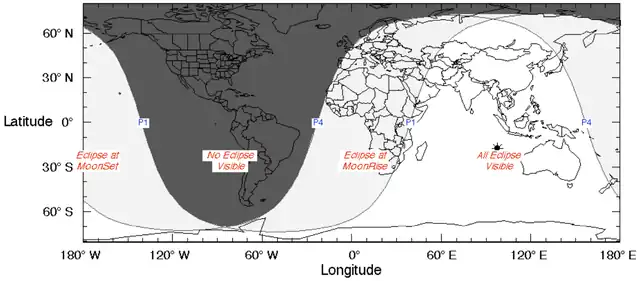 Visibility map |
Gallery
 Perth, Australia, 16:48 UTC
Perth, Australia, 16:48 UTC Astronomical telescope view from Kuching, Malaysia, 17:26 UTC
Astronomical telescope view from Kuching, Malaysia, 17:26 UTC.jpg.webp) Moscow, Russia, 17:49 UTC
Moscow, Russia, 17:49 UTC.jpg.webp) Moonrise and moon track during eclipse in Moscow, 17:56 UTC
Moonrise and moon track during eclipse in Moscow, 17:56 UTC.jpg.webp) Penumbral eclipse of 5 May 2023 taken from Oria, Italy at 18:17 UTC
Penumbral eclipse of 5 May 2023 taken from Oria, Italy at 18:17 UTC
Member
This was the 24th member of Lunar Saros 141. The previous event was the April 2005 lunar eclipse. The next event is the May 2041 lunar eclipse.
Related eclipses
Eclipses of 2023
- A hybrid solar eclipse on 20 April
- A penumbral lunar eclipse on 5 May
- An annular solar eclipse on 14 October
- A partial lunar eclipse on 28 October
Lunar year series
| Lunar eclipse series sets from 2020–2023 | ||||||||
|---|---|---|---|---|---|---|---|---|
| Descending node | Ascending node | |||||||
| Saros | Date | Type Viewing |
Gamma | Saros | Date Viewing |
Type Chart |
Gamma | |
111 |
2020 Jun 05 |
Penumbral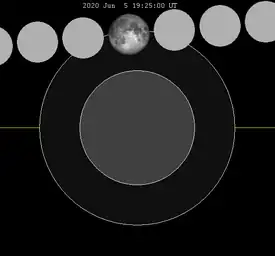 |
1.24063 | 116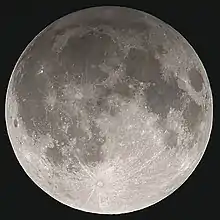 |
2020 Nov 30 |
Penumbral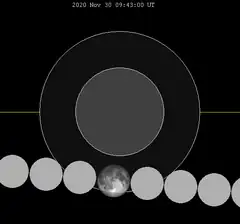 |
−1.13094 | |
121 |
2021 May 26 |
Total |
0.47741 | 126_(cropped).jpg.webp) |
2021 Nov 19 |
Partial |
−0.45525 | |
131_(cropped).jpg.webp) |
2022 May 16 |
Total |
−0.25324 | 136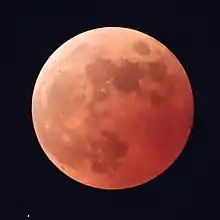 |
2022 Nov 08 |
Total |
0.25703 | |
141 |
2023 May 05 |
Penumbral |
−1.03495 | 146 | 2023 Oct 28 |
Partial |
0.94716 | |
| Last set | 2020 Jul 05 | Last set | 2020 Jan 10 | |||||
| Next set | 2024 Mar 25 | Next set | 2024 Sep 18 | |||||
Metonic series
This eclipse is the last of four Metonic cycle lunar eclipses on the same date, 4–5 May, each separated by 19 years:
The metonic cycle repeats nearly exactly every 19 years and represents a Saros cycle plus one lunar year. Because it occurs on the same calendar date, the earth's shadow will in nearly the same location relative to the background stars.
| Metonic events: May 4 and October 28 | |
|---|---|
| Descending node | Ascending node |
|
|
 |
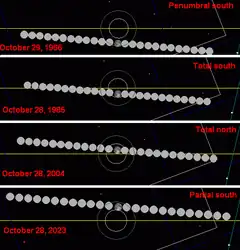 |
Tritos series
- Preceded: Lunar eclipse of 4 June 2012
- Followed: Lunar eclipse of 3 April 2034
Tzolkinex
- Preceded: Lunar eclipse of 23 March 2016
- Followed: Lunar eclipse of 15 June 2030
Half-Saros cycle
A lunar eclipse will be preceded and followed by solar eclipses by 9 years and 5.5 days (a half saros).[2] This lunar eclipse is related to two annular solar eclipses of Solar Saros 148.
| 29 April 2014 | 9 May 2032 |
|---|---|
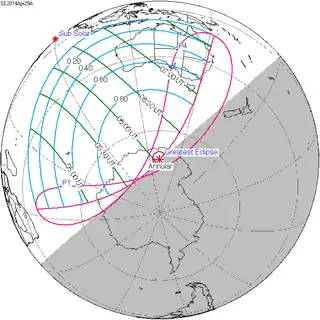 |
 |
References
- "Penumbral Lunar Eclipse on May 5–6, 2023 – Where and when to See".
- Mathematical Astronomy Morsels, Jean Meeus, p.110, Chapter 18, The half-saros
